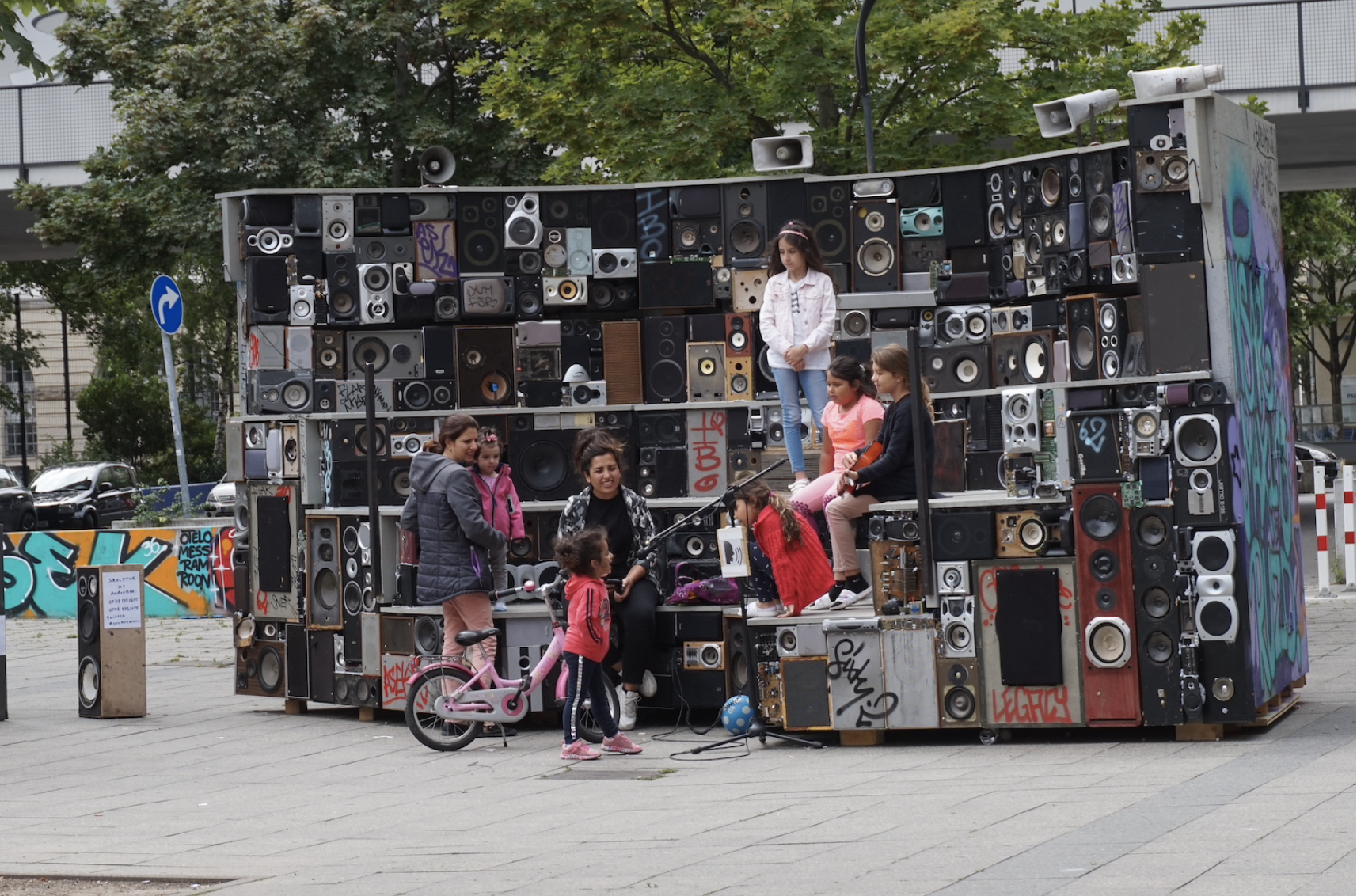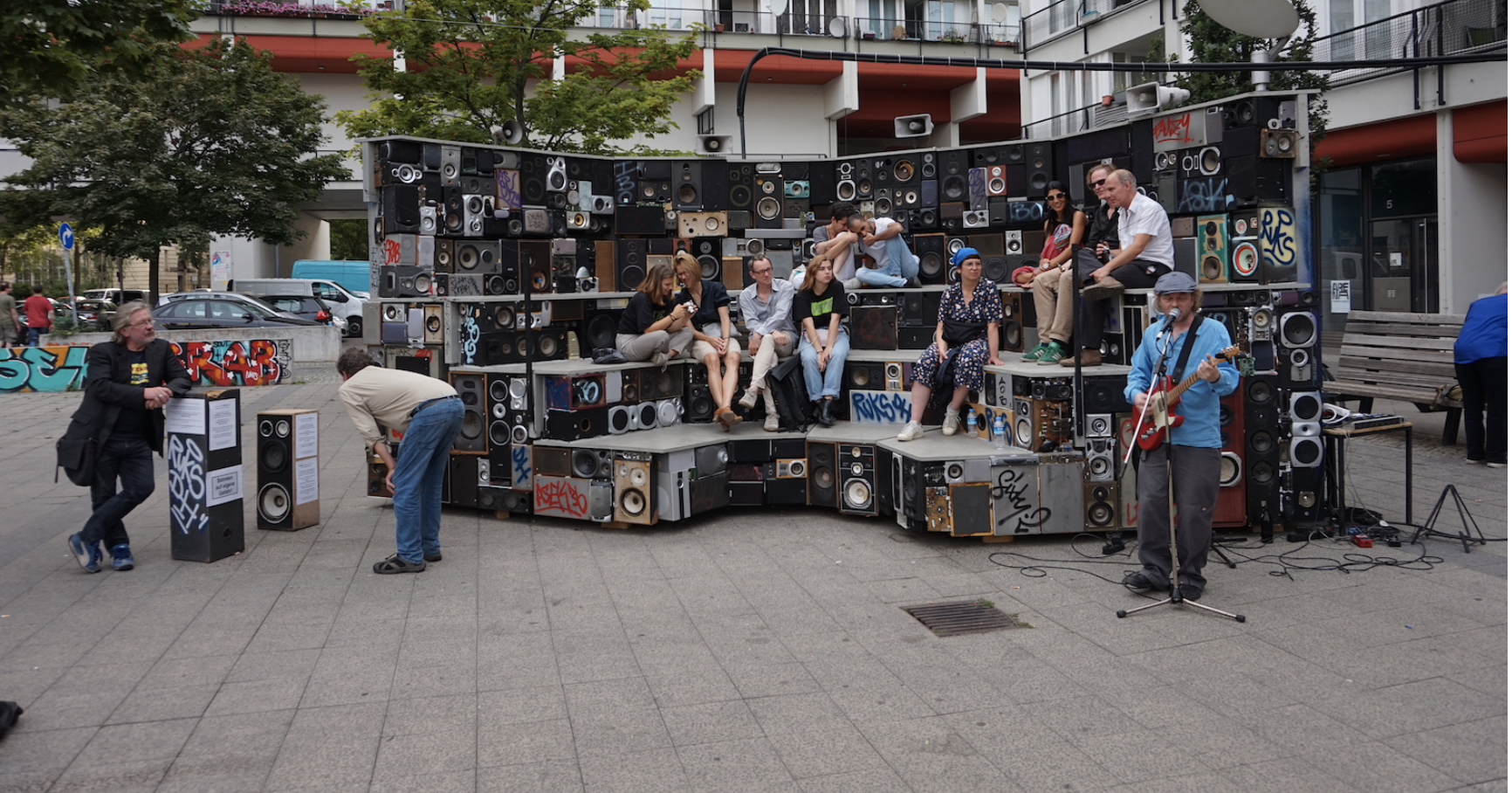Bio,
My artwork has evolved considerably over the past decade with the advent of new technology and social media. I have gone from creating mobile sound costumes that interact with their environment to my current work creating public speaker sculptures that all audiences can participate in. This project is a catalyst for my professional growth because I plan to integrate cell phone answering systems, social media platforms, and streaming video to make the sculpture responsive to new media. This will make my work more accessible, including across younger generations, expanding the realm of public art.
Explain your practice
My decision in the early 1980s to stop working with pigments and canvas came from a desire to interact directly with public spaces. This is why I decided to work with loudspeakers and media. Loudspeakers have long been integrated into modern life inside our homes, mass transportation, and public spaces. Speakers are cheap and commonplace: they can be found at flea markets, second-hand stores, or
recycling centers. For people in general (we like to collect them also from locals) loudspeakers have a personal touch or patina.
Artistically I use loudspeakers much in the same way that a sculptor uses clay or wood: as modern building blocks to create artworks but their main purpose is to supply sound to a public space and create a public "hotspot". By using the sculpture for playing their music, talking via their cells phones, and expressing themselves via "hearable" social media their voices become an integral part of the sculpture.
Since 1990 I have been creating interactive sound sculptures made with hundreds of recycled speakers. Found in public places, these electroacoustic sculptures have taken on various shapes like a gateway, an arena, a temple, an igloo, or a wall. The speakers are all connected and allow passersby to express themselves through them: the sculptures are equipped with an amplifier, a mixing board, Bluetooth receivers, telephone answering systems (anyone can call up the sculpture and talk through it for 3 minutes), a Twitter (now X) text-to-speech messaging system, and —most recently— a live streaming video camera. Community organisations can use the sculpture for meetings and events.
My work is site-specific: each project is created specially for a public space, sometimes directly embedded into a pre-existing structure. The artwork itself can be created on-site in cooperation with recycling companies (Goodwill, Salvation Army), youth organisations (every family has old loudspeakers stored in their attic), and local associations. The work is about communication, cooperation, collaboration, fun, and fantasy.
Impact:
Why shouldn't a public sculpture speak?
Why shouldn't a sculpture be used by local cultural organizations to mobilize communities and reflect their cultural expressions?
This is the main goal of my sculpture: not a mute statue made of marble or granite but a socially responsive structure created through cooperation with local people and networks.
This project is public. It belongs to the neighbourhood.
Individuals and casual passers-by can use the sculpture and participate in several ways:
— via microphones, MP3 players, cell phones (calls are automatically answered and amplified), and musical instruments.
— via Bluetooth.
— via the Internet and Streaming video callers can see the the public that they are communicating with and talk to them.
— via “audio Twitter” (#speakerssculpture) and other Social Media (Clubhouse, Instagram...) integrated as sound input sources.
— artists and local clubs/organizations can host gatherings and photo/video shoots.
— the project will include a public call for individuals to donate old speakers as hardware for the sculpture. Local recycling businesses and thrift shops can cooperate as e-waste partners.
2 - Is art relevant today?
Of course, we cannot survive without art
3. we want to know what art you don’t like…
The kind that hangs on walls and sometimes has red dots pasted below it.
and which influences you?
Fluxus, Dada, John Cage, Christo.
4- If you could go back 10-20 years what would you tell your younger self?
Keep moving on and hope you stay lucky.
5 – If you could go forward 10-20 years what do you hope to have done or not done?
More of what I am doing now but less work
SPEAKER SCULPTURES Brief description:
A public sound sculpture that allows people to express themselves either live (on the spot) or via the Internet. The sculpture is created site-specifically, it can be free-standing or integrated into local structures/buildings/topographies: it is created in cooperation with local organizations.
Detailed description
The sculpture is constructed from e-waste. Local people are invited to donate their second-hand speakers, amplifiers, and radios as hardware for the sculpture. Regional recycling businesses and thrift shops can be acquired as partners. 300 - 500 recycled loudspeakers are connected and powered through an amplifier.
The sculpture's MAIN PURPOSE is to allow neighborhood residents, artists, musicians, choral groups, and passersby to use the sculpture as a “Speakers Corner“.
They can participate via several ways:
— connect their microphones, MP3 players, and instruments directly to it.
— call either one of two available telephone numbers to express themselves for 3 minutes.
Web Links:
SPEAKER SCULPTURES: https://www.benoitmaubrey.com/?cat=5
Video link SPEAKER SCULPTURES: https://vimeo.com/66304704
Web links to past projects:
https://benoitmaubrey.com/arena-berlin/
https://benoitmaubrey.com/arena-2/
Video link: Deutsche Welle English
https://www.dw.com/en/beno%C3%AEt-maubreys-interactive-soundscapes/av-49781881
OBELISK
https://benoitmaubrey.com/obelisk/
SHRINE
https://benoitmaubrey.com/shrine/
Artistically I use loudspeakers much in the same way that a sculptor uses clay or wood: as modern building blocks to create artworks but their main purpose is to supply sound to a public space and create a public "hotspot". By using the sculpture for playing their own music, talking via their cells phones and expressing themselves via "hearable" social media their voices become an integral part of the sculpture.
Why shouldn't a public sculpture speak?
Why shouldn't a sculpture be used by local cultural organizations to mobilize communities and reflect their cultural expressions?
This is the main goal of my sculpture: not a mute statue made of marble or granite but a socially responsive structure created through cooperation with local organizations





